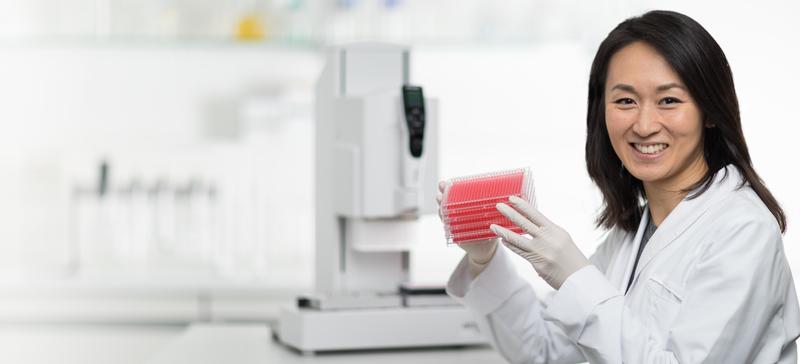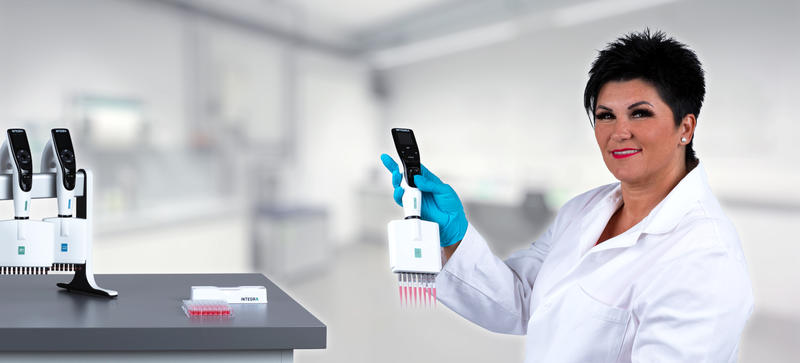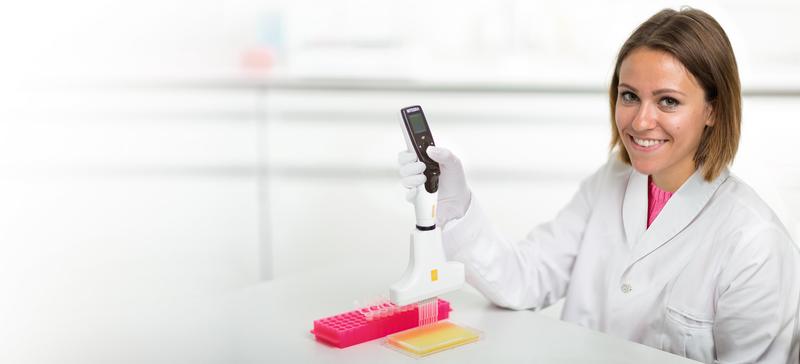-
Automated nucleic acid extraction and RT-PCR set-ups for SARS-CoV-2 testing
Using the ASSIST PLUS pipetting robot to simplify the preparation of NAE and RT-PCR plates for COVID-19 testing
The emergence of the novel coronavirus SARS-CoV-2 in China in January led to an increasing number of patients in the country infected with COVID-19, with the total peaking on February 12th. In March, China saw the number of COVID-19 cases start to fall, due to the local authorities enforcing regulations requiring residents to stay indoors. At the same time, other countries worldwide saw the number of infected individuals rise. To prevent new infection peaks in the country, Chinese customs authorities took immediate action to help control the spread of COVID-19, testing all nationals returning from other countries. This required rapid implementation of COVID-19 testing and automation of sample preparation processes. The ASSIST PLUS pipetting robot was chosen to meet this need, together with VOYAGER adjustable tip spacing pipettes, Wide Bore and Low Retention GRIPTIPS® and divided reagent reservoirs, to speed up and organize set-up of nucleic acid extraction (NAE) and RT-PCR.
-
Table of contents
The emergence of the novel coronavirus SARS-CoV-2 in China in January led to an increasing number of patients in the country infected with COVID-19, with the total peaking on February 12th. In March, China saw the number of COVID-19 cases start to fall, due to the local authorities enforcing regulations requiring residents to stay indoors. At the same time, other countries worldwide saw the number of infected individuals rise. To prevent new infection peaks in the country, Chinese customs authorities took immediate action to help control the spread of COVID-19, testing all nationals returning from other countries. This required rapid implementation of COVID-19 testing and automation of sample preparation processes. The ASSIST PLUS pipetting robot was chosen to meet this need, together with VOYAGER adjustable tip spacing pipettes, Wide Bore and Low Retention GRIPTIPS® and divided reagent reservoirs, to speed up and organize set-up of nucleic acid extraction (NAE) and RT-PCR.
Key benefits
- Automating the VOYAGER adjustable tip spacing pipettes on the ASSIST PLUS provides a safe, reliable and ergonomic pipetting method that eliminates the risk of patient sample reformatting errors and minimizes manual intervention.
- The compact and easy-to-use ASSIST PLUS pipetting robot allows fast set-up regarding installation and programming, allowing labs to immediately implement, or increase their sample processing capacity for, COVID-19 testing.
- Optimal pipette settings, including tip immersion depth, the use of air gaps, and pipetting speeds and angles, deliver precise and reproducible results and reduce contamination risks.
- The use of INTEGRA’s divided reagent reservoirs with SureFlo™ anti-sealing array, together with Low Retention GRIPTIPS, enables efficient handling of the precious and expensive RT-PCR Mastermix used for patient testing.
Overview: Automated RT-PCR set-up
The ASSIST PLUS pipetting robot is used to automate the testing of suspected COVID-19 positive cases in 96 well plates. The following procedure is based on the protocols used by Gansu Lanzhou Customs in China and shows an example of setting up a viral NAE followed by RT-PCR to determine the presence of the novel coronavirus in human samples.
The pipetting robot operates a VOYAGER 4 channel 1250 μl electronic pipette with 1250 μl Sterile, Filter, Wide Bore GRIPTIPS to transfer the patient samples into the NAE plate. The templates were extracted from nasopharyngeal/oropharyngeal flocked swabs. After NAE, the ASSIST PLUS was used together with a VOYAGER 8 channel 50 μl electronic pipette with 125 μl Sterile, Filter, Low Retention GRIPTIPS to set up the RT-PCR before further processing to store the RNA samples in microcentrifuge tubes.
The protocol is divided into three parts:
- Program 1: Nucleic acid extraction set-up (1-NAE-Set-up)
- Program 2: RT-PCR set-up (2-RT-PCR-Set-up)
- Program 3: Sample transfer for storage (3-RNA-Sample-Storage)
Downloads: Protocols and reports for automated nucleic acid extraction and RT-PCR testing for COVID-19 with ASSIST PLUS
Here you can download the complete protocols and reports used in this application and use them on your ASSIST PLUS. The protocol can be customized with the VIALAB software.
Experimental set-up: Program 1
|
Deck position B: |
Human samples placed in tubes in an INTEGRA rack for 15 ml centrifuge tubes. |
| Deck position C: |
96 well, deep well plate used for subsequent NAE step. |
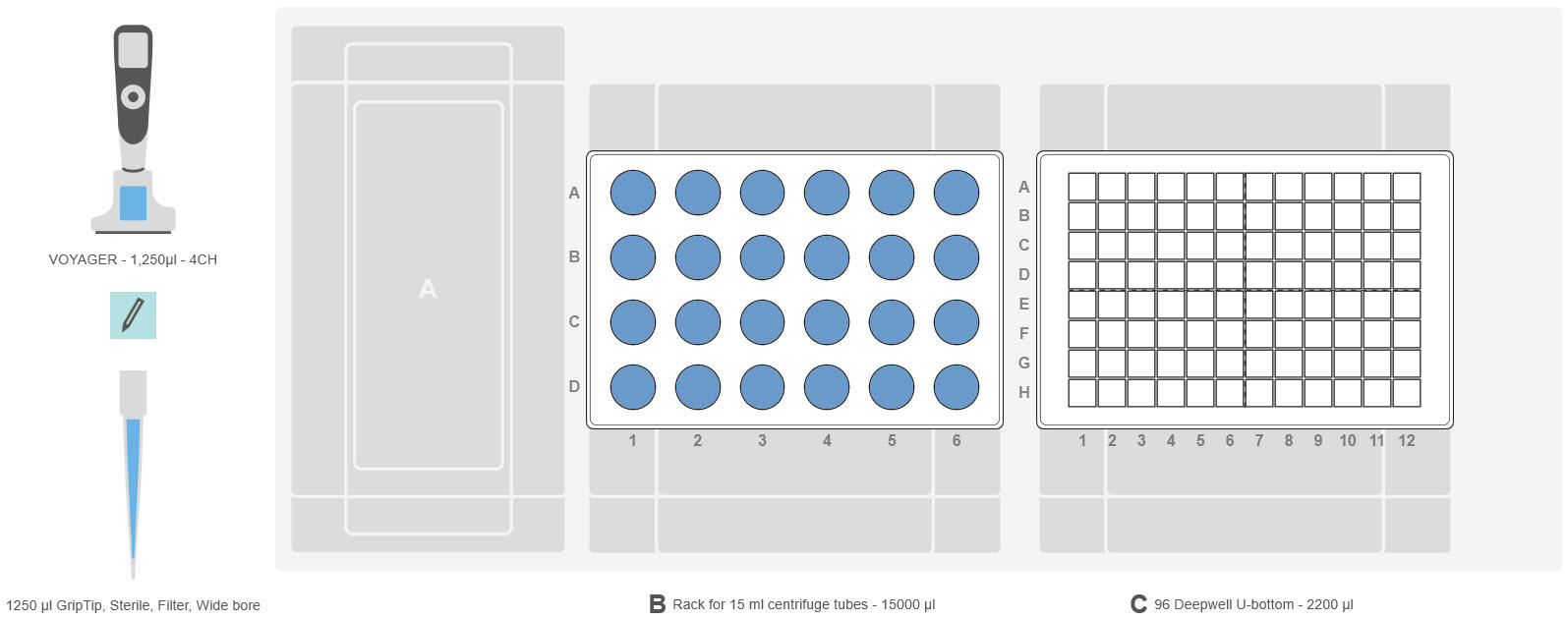
Step-by-step procedure
1. Nucleic acid extraction set-up
Transfer the human samples in the NAE plate
The ASSIST PLUS pipetting robot operates a VOYAGER 4 channel 1250 μl electronic pipette with 1250 μl Sterile, Filter, Wide Bore GRIPTIPS. Human samples in tubes are placed in four INTEGRA racks containing 24 tubes each (Figure 1). Prepare the deck with the required labware, as indicated in Figure 2. Select and run the VIALAB program 1-NAE-Set-up on the pipette. The VOYAGER pipette mixes the samples twice at low speed, to avoid aerosols while homogenizing the liquid. It then aspirates 200 μl of each sample followed by a 25 μl air gap before transferring the samples into the NAE plate. The pipette prompts the user to place a new sample rack on the deck once transfer of the samples in the current rack is complete. The program ends when all tubes have been processed. The plate is then ready for the NAE step.
Tips:
- The mixing and aspiration heights are optimized to allow the tips to access and pipette the liquid in the presence of the swab.
- The use of Sterile, Filter, Wide Bore GR is proven to be ideal when mixing and pipetting human samples for the NAE set-up.
- The pipetting speeds are set to speed 2 to reduce the generation of aerosols during sample handling.
- Adding an air gap after aspiration of critical liquids, together with the tip travel feature and the use of filter tips, helps to minimize the risk of contamination.
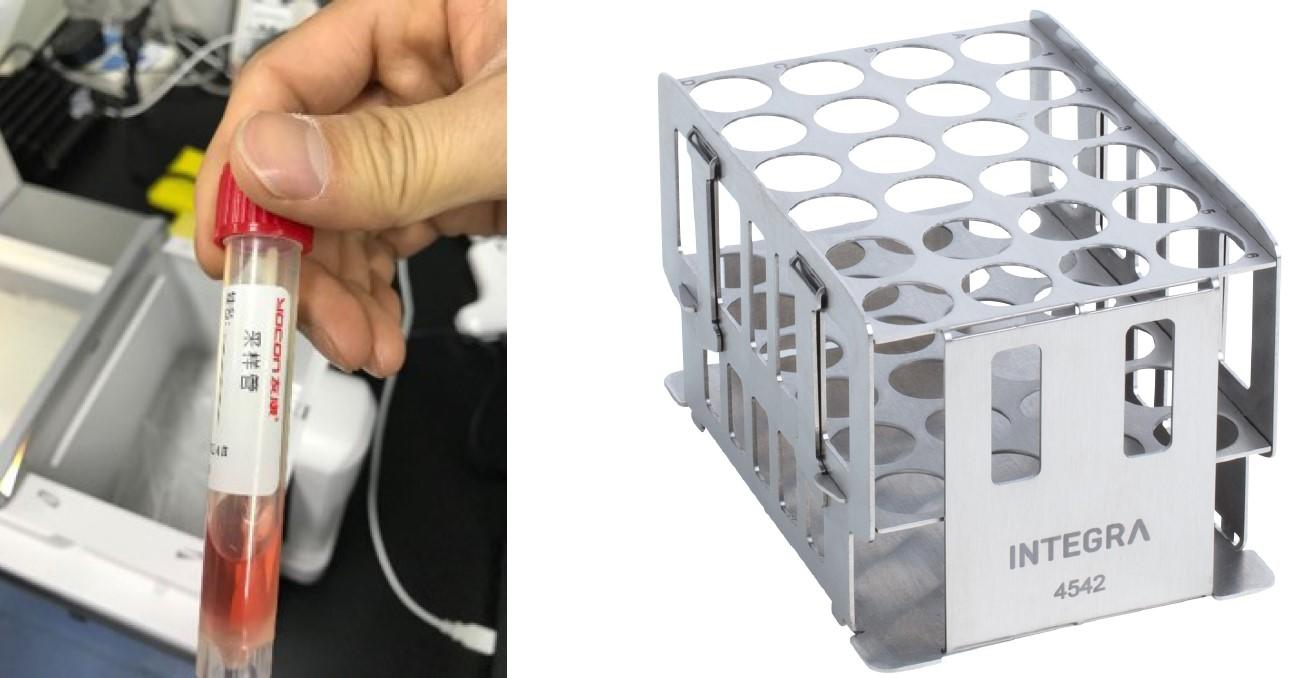
Experimental set-up: Program 2
|
Deck position A: |
Dual reservoir adapter shown with one 25 ml, polypropylene divided reagent reservoir with SureFlo anti-sealing array. The 5 ml compartment contains the Mastermix. |
|
Deck position B: |
96 well, deep well plate containing the extracted nucleic acid templates. |
| Deck position C: |
well PCR plate placed on an INTEGRA PCR cooling block. |
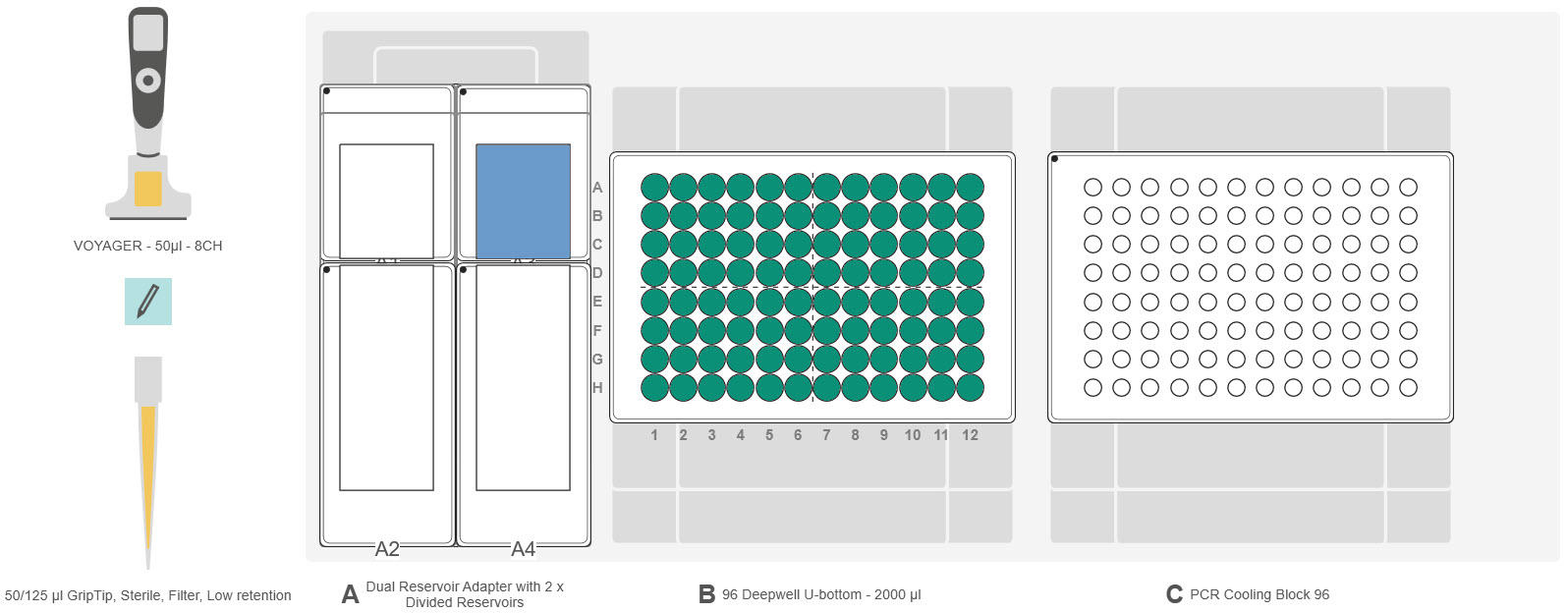
Step-by-step procedure
2. RT-PCR set-up
Set up the PCR plate
The ASSIST PLUS deck is prepared as indicated in Figure 3. The pipetting robot operates a VOYAGER 8 channel 50 μl together with Low Retention, Sterile, Filter GRIPTIPS. Place a dual reservoir adapter on Position A. Insert a sterile, 25 ml polypropylene divided reagent reservoir. The reservoir features a SureFlo anti-sealing array that allows an even distribution of the liquid on the bottom of the reservoir and prevents pipette tips from sealing, for maximum liquid recovery. The 96 well, deep well plate containing the extracted nucleic acid templates is placed on Position B, while the PCR plate, used with an INTEGRA PCR cooling block, goes on Position C. Select and run the VIALAB program 2-RT-PCR-Set-up. The pipette transfers the Mastermix from the reservoir into the PCR plate using the Repeat Dispense mode, followed by the extracted samples. The plate is then ready for the RT-PCR step.
Tips:
- The PCR cooling block is used as a support for the 0.1 ml MicroAmp™ Fast Optical 96-Well Reaction Plate. The cooling block also helps to keep the samples cold when the protocol requires it.
- Using the 5 ml compartment side of a 25 ml divided reagent reservoir – polypropylene with SureFlo anti-sealing array – allows a very low dead volume and minimizes the loss of the expensive Mastermix.
- The combination of a low pipetting speed – set at 2 – and Low Retention GRIPTIPS and pre- and post-dispense volumes shows excellent results when pipetting the viscous and foamy Mastermix.
- Using an air gap of 1.5 μl when aspirating the viral nucleic acid templates prevents the risk of contamination during sample transfer from one plate to another.
Experimental set-up: Program 3
|
Deck position B: |
96 well, deep well plate containing the extracted nucleic acid templates. |
| Deck position C: |
INTEGRA rack for 1.5 microcentrifuge tubes, containing 48 empty tubes. |
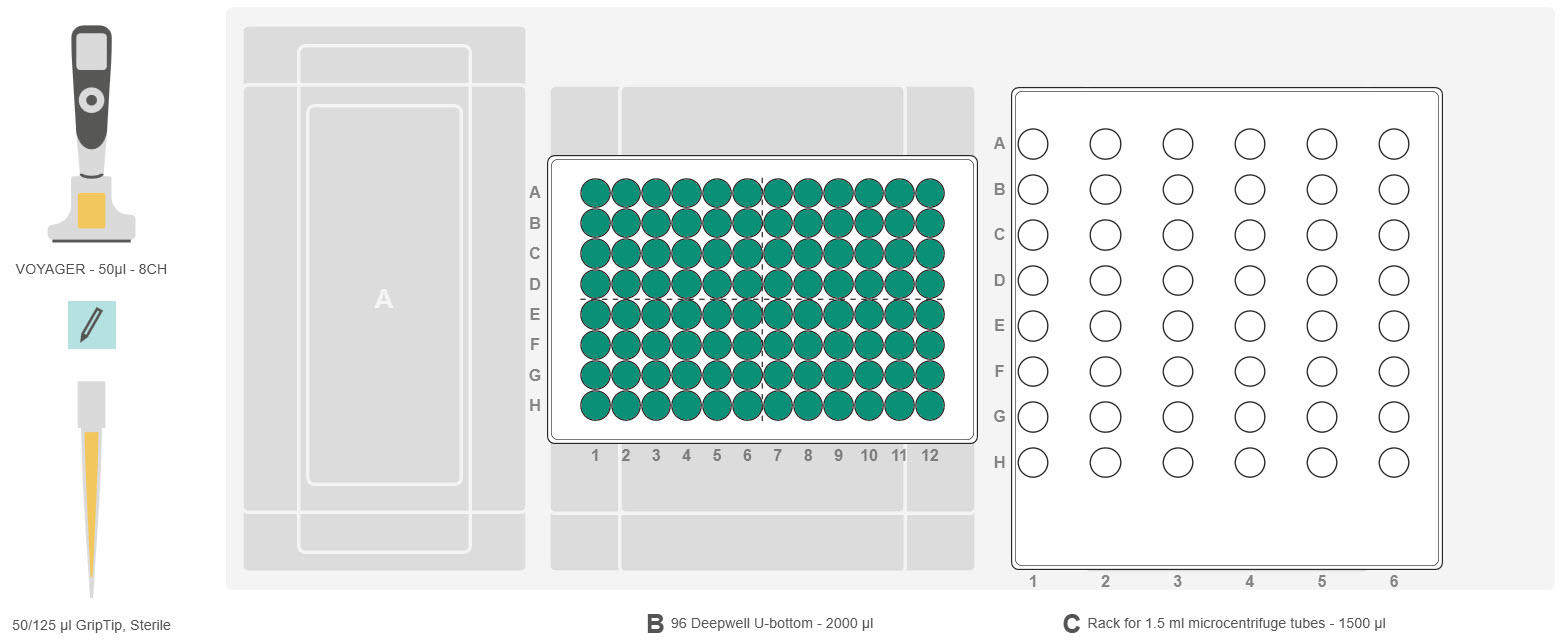
3. Nucleic acid template storage
Transfer the nucleic acid samples into microcentrifuge tubes
Prepare two racks with 48 1.5 ml microcentrifuge tubes and place the first one on Position C (see Figure 4) of the deck. The deep well plate containing the nucleic acid templates is still on Position B. Choose the VIALAB program 3-RNA-Sample-Storage on the VOYAGER pipette. The pipette transfers the samples into the microcentrifuge tubes and informs the user when the second rack needs to be placed on the deck.
Tips:
- The combination of the tip spacing capability of the VOYAGER pipette, the automatic tip change, and optimized pipetting settings ensures an easy and rapid sample transfer without risk of contamination or reformatting errors.
- A 1.5 μl air gap has been added at the end of the aspiration to prevent cross-contamination risk.
Remarks
VIALAB software:
The VIALAB programs can be easily adapted to your specific labware and protocols, for instance when partial plates are needed.
Partial plates:
Programs can be adapted at any time to a different number of samples, giving laboratories total flexibility to meet current and future demands.
Conclusion
- While the novel coronavirus responsible for COVID-19 spreads all over the world, laboratories are under increasing pressure to analyze more and more patient samples to confirm positive cases. In this context, the use of automated pipetting solutions that can easily and rapidly support existing or new testing labs is highly appreciated, especially for NAE and RT-PCR set-ups that involve patient sample reformatting steps.
- The ASSIST PLUS pipetting robot is quick to install and easy to use. Together with the VOYAGER adjustable tip spacing pipettes, it eliminates all risks of reformatting errors, reduces the need for manual intervention by laboratory personnel and increases sample processing capacity. The use of Low Retention GRIPTIPS and INTEGRA’s divided reagent reservoirs with SureFlo anti-sealing array reduces the dead volume of costly reagents, such as the RT-PCR Mastermix for COVID-19 testing.
- Thanks to the VIALAB software, the pipetting programs can be easily adapted to any specific protocols, labware and sample numbers, offering immediate help for testing labs.
Ask our expert. Leave a comment!
Write us if you have any questions regarding the application note or one of our instruments.
Any questions? I'm happy to help!
Instruments and accessories
ASSIST PLUS, Pipetting Robot
INTEGRA has developed the ASSIST PLUS pipetting robot to streamline routine pipetting tasks at an affordable price. Using INTEGRA electronic multichannel pipettes, the system:
- automates pipetting tasks,
- eliminates physical strain and
- ensures superior reproducibility and
- error free pipetting.
Part No. 4505
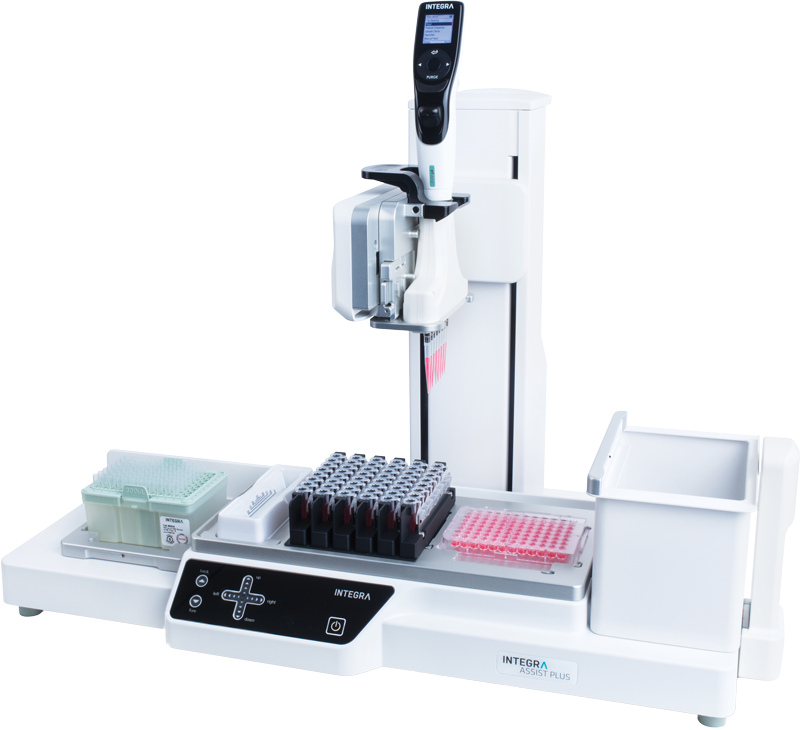
VOYAGER, 4 Channel, 1250 µl
VOYAGER pipettes allow the tip spacing to expand anywhere between 4.5 mm and 33 mm at the push of a button.
- Single handed operation leaves the other hand free to handle labware.
- On the fly access to up to 3 user-defined tip spacings.
- These user defined tip spacings are saved. No need to memorize spacings of different labware formats.
Part No. 4744
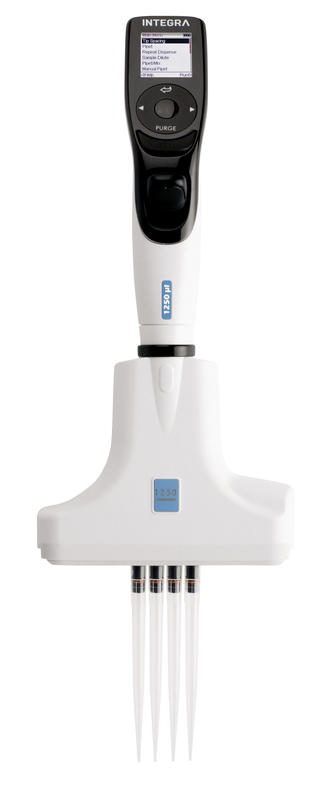
VOYAGER, 8 Channel, 50 µl
VOYAGER pipettes allow the tip spacing to expand anywhere between 4.5 mm and 33 mm at the push of a button.
- Single handed operation leaves the other hand free to handle labware.
- On the fly access to up to 3 user-defined tip spacings.
- These user defined tip spacings are saved. No need to memorize spacings of different labware formats.
Part No. 4726
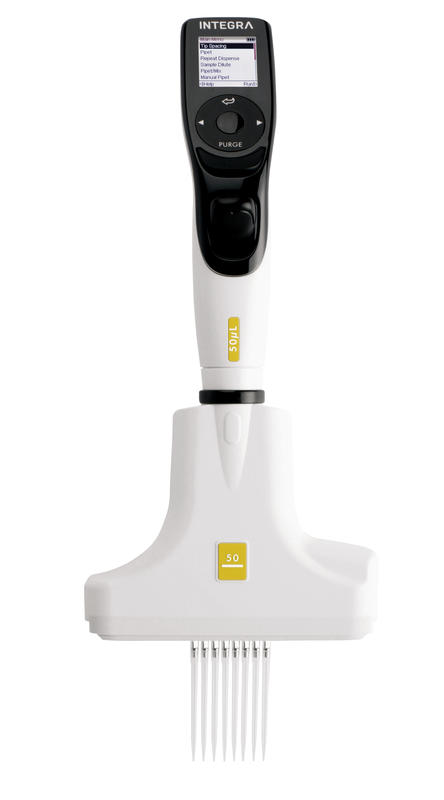
Rack for 15 ml centrifuge tubes, 4x6 tubes
This tube rack is designed to hold 15 ml centrifuge tubes in a 4x6 ANSI/SLAS format.
Part No. 4542
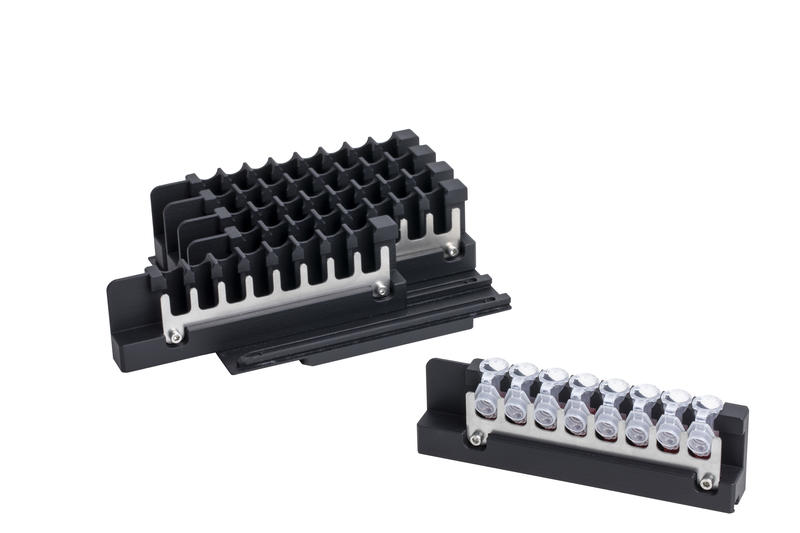
Rack for 1.5/2 ml microcentrifuge tubes
Hold up to 48 tubes on removable carriers for easy loading and storage.
Part No. 4540

Dual Reservoir Adapter
The dual reservoir adapter makes this system ideal for assays that required sequential addition of several low volume reagent mixes. This adapter holds two 10 ml, 25 ml or divided reagent reservoirs side by side in an aluminum frame, and can be pre-chilled to keep reagents cool during processing.
Part No. 4547
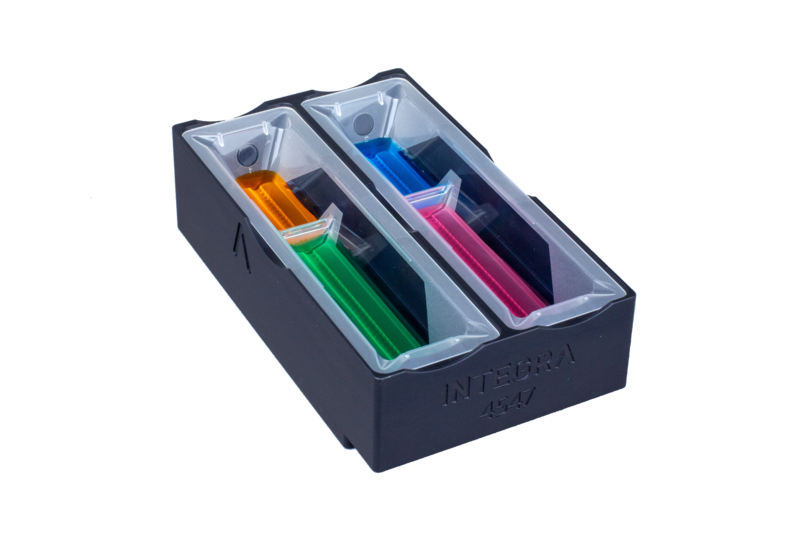
PCR 96 well cooling block
Aluminium 96 and 384 well PCR cooling blocks that keep reagents chilled during sample preparation in a PCR plate. The cooling blocks feature a SBS footprint.
Part No. 6250
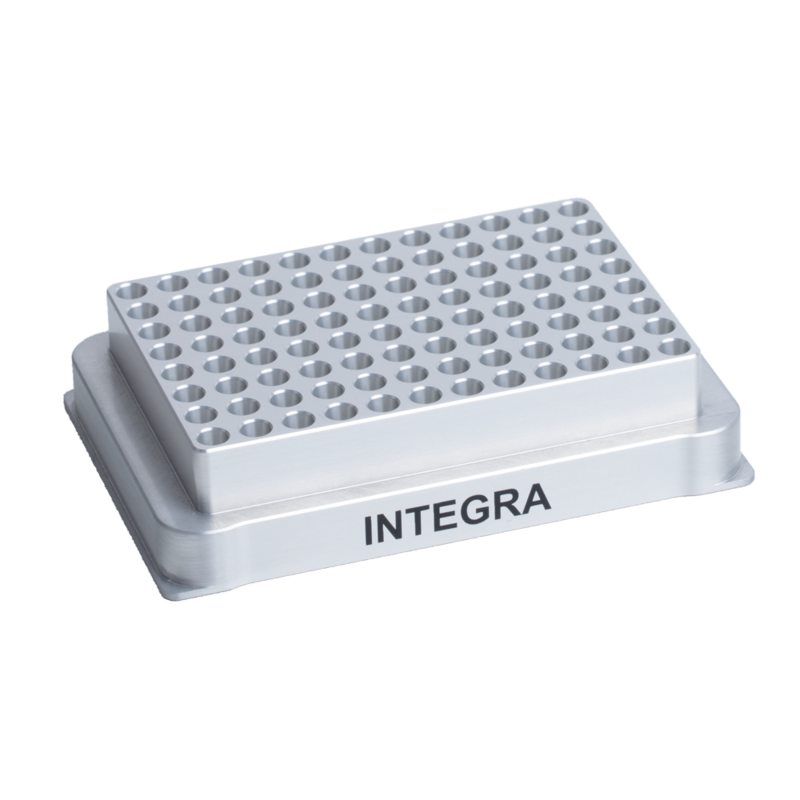
GRIPTIPS®, 1250 µl, Sterile, Filter, Wide Bore
GRIPTIPS® pipette tips perfectly match the multi-lobe tip fitting, snapping firmly on during loading. This guarantees a perfect seal on every tip, preventing them from loosening, leaking or completely falling off. All tips are precisely aligned horizontally, enabling accurate touch-offs, even when pipetting with 384 tips.
Part No. 6445
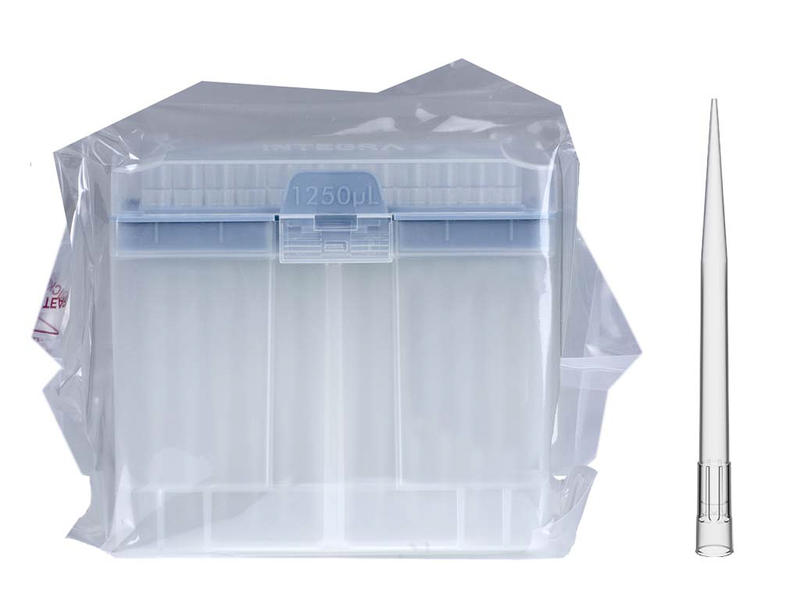
GRIPTIPS®, 125 µl, Sterile, Filter, Low retention
INTEGRA uses a unique polypropylene blend to mold Low Retention GRIPTIPS® with heightened hydrophobic properties. Using Low Retention GRIPTIPS® prevents low surface tension samples from spreading out and “wetting” the inner wall of the tips, allowing them to bead-up for a maximum liquid recovery.
Part No. 6565
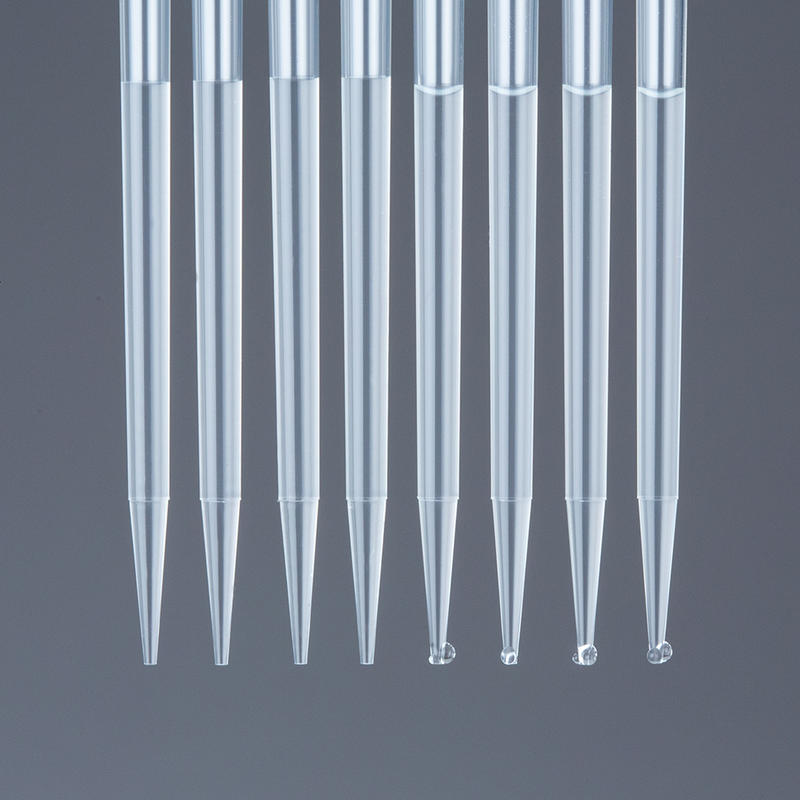
Divided Reagent Reservoir, Sterile, SureFlo anti-sealing array, 25 ml, PP
Lowest Dead Volume On The Market!
25 ml divided reservoirs are comprised of 5 and 10 ml compartments, while still nesting comfortably in the standard 25 ml reusable, sturdy base.
Each reservoir features the SureFlo™ anti-sealing array and hydrophilic surface treatment providing especially low dead volumes.
Part No. 4356 / 4357
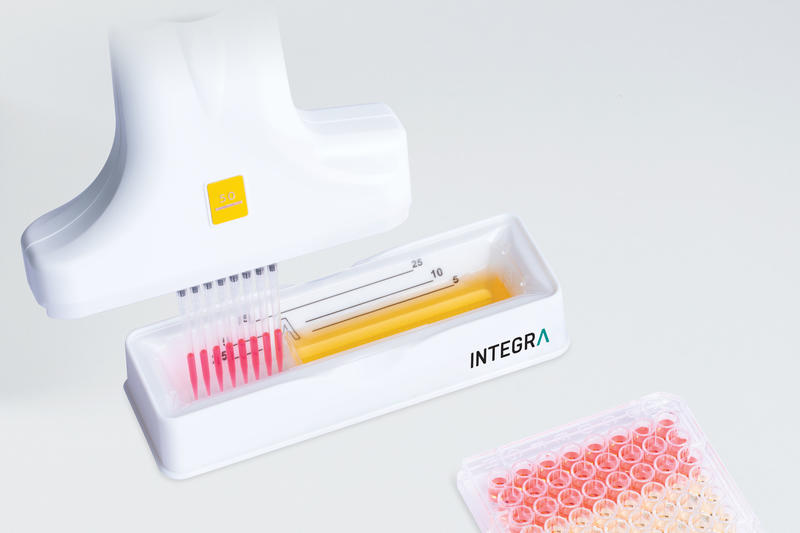
Applied Biosystems®: MicroAmp™ Fast Optical 96-Well Reaction Plate, 0.1 ml
The Applied Biosystems® MicroAmp® Fast Optical 96-Well Reaction Plate is an integral component of the Applied Biosystems® Fast PCR Systems, which reduces PCR reaction time from 2 hours to as little as 25 minutes.
• Maximum thermal conductivity for precise thermal cycling
• Reproducible, specific, and sensitive PCR results in just 25 minutes
• Validated with other system components for consistent results
Source: Website Thermo Fisher Scientific
Thermo Scientific™, Nunc™ 96-Well Polypropylene DeepWell™ Storage Plates
Increase storage capacity and improve mixing using Thermo Scientific™ Nunc™ 1.3 and 2.0mL DeepWell™ Plates with Shared-Wall Technology. Ideal for sample collection, storage, combinatorial chemistry and library applications, and resistant to most chemicals, solvents and alcohols used in combinatorial chemistry.
Source: Website Thermo Fisher Scientific
Sarstedt: MegaBlock® 96 Well, 2.2 ml, PP
Deep Well MegaBlock®, 96 Well, 2,2 ml, PP, quadratische Wells mit Rundboden, frei von DNase, RNase, Endotoxinen und humaner DNA, autoklavierbar (121°C / 20 Min.), SLAS-Standard, kompatibel mit Pipettierautomaten / Mehrkanalpipetten, 32 Stk./Karton
Source: Website SARSTEDT AG & Co. KG
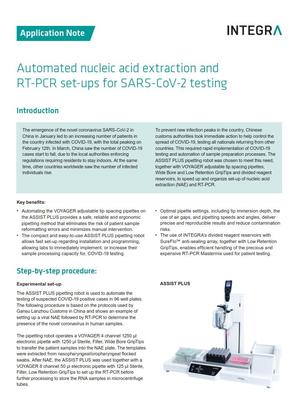
Download
Download this App Note as PDF file
DownloadAutomated nucleic acid extraction and RT-PCR set-ups for SARS-CoV-2 testingCustomer’s voice
Perfect for medium to high throughput labs! This instrument fills a perfect gap in sample throughput. Our lab handles too many samples for manual processes, but doesn't have the throughput, space or funding for high-end automation systems. This robot suits us perfectly!

